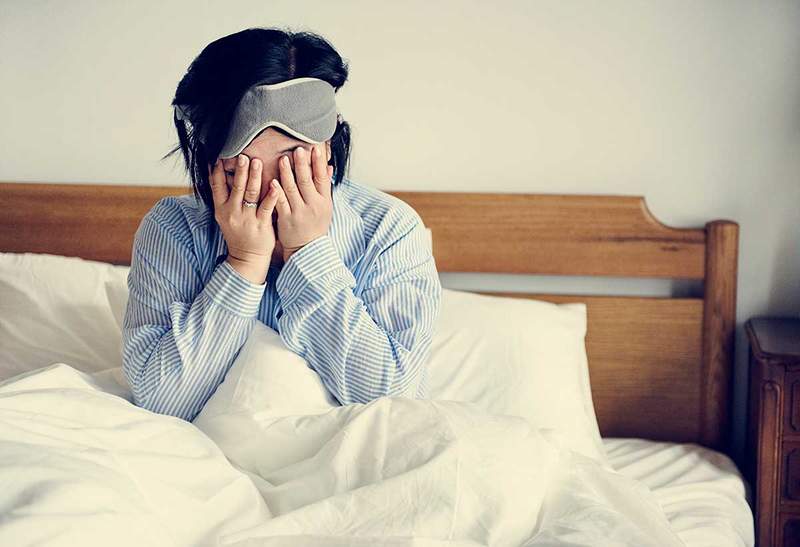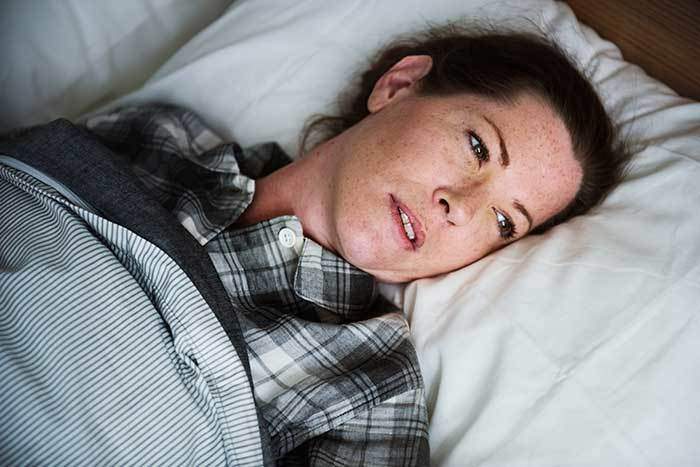Sleep disorders, everything you need to know

- 2059
- 292
- Austin Stokes
The sleep disorders They are divided into two large groups: dysomnias and parasomnias. Later we will see the causes and main characteristics of these alterations.
Content
Toggle- Sleep disorders: Dysomnias
- Insomnia
- Causes of insomnia
- Consequences of insomnia
- Primary insomnia
- Hypersomnia
- Narcolepsy
- Causes of Narcolepsy
- Sleep disorders related to breathing
- Circadian rhythm disorders
- Other sleep disorders: parasomnias
- Nightmares
- Night terrors
- Somnambulism
- References
Sleep disorders: Dysomnias
This category of sleep disorders is related to the duration, intensity and quantity of sleep.
Insomnia
Insomnia is an alteration of sleep that implies difficulty starting to sleep or staying asleep. Once the subject gets up, he will be unable to return to sleep, although it will cost him to be fresh and active in the morning. For a person to be diagnosed with insomnia disorder, he must meet the following characteristics:
- That at least 3 nights occur in the week and for 3 months
- Discard some other sleep disorder
- That is not related to the use of a substance
- That is not explained by mental or medical disorders
- It is due to psychological, biological and/or environmental factors
Causes of insomnia
In general, People who suffer from insomnia have erroneous or unhealthy routines that have an impact on the quality and quantity of your dream, for example:
- Irregular schedules
- Swaper copiously
- Consume alcohol before bed
- Intense exercise at night
- Go to bed too soon
- Perform jobs or activities that require high brain stimulation during the night
- Ingest exciting drinks or stimulating substances before bedtime
- Live in sectors with a lot of noise
- The ambient temperature is extreme
- They are living a stressful situation
- Symptom that accompanies anxiety, depression, mania, or some dementia

Consequences of insomnia
The consequences of not complying with the 8 hours of sleep diary can generate in the individual:
- Functional deterioration
- Loss of productivity
- Attention problems
- Memory deterioration
- Less ability to relate at the interpersonal level
- Alterations in mood
- Hormonal and metabolic problems
- Stunted growth
- Early aging
- Weight gain
Primary insomnia
This type of insomnia is characterized that it cannot be attributed with certainty a particular cause, although it is believed that Stress could be a trigger. In many cases it arises in childhood and can be extended throughout life, increasing with age.
The symptoms that will be presented in the subjects will be: fatigue, tiredness, headaches, muscle tension and gastric discomfort. The reason why this type of insomnia is prolonged is that the subject is constantly concerned about his state, that he will have difficulty reconciling the dream during the night.
Therefore, a state of anxiety and tension develops during the day they cause a sleep alteration at night. This disorder can also produce a kind of daytime hypersomnia.
Hypersomnia
Hypersomnia is characterized by a excessive sleepiness that can be nocturnal (greater than or equal to 10 hours) or day (Frequent naps that can hard more than 1 hour). It usually starts around 15 and 35 years and tends to chronicity.
For this episode to be considered a disorder, it must occur for at least 1 month. In addition, it will not be associated with another medical disorder or the effects of a substance, and the narcolepsy will have been discarded previously.
Patients suffering from this disorder They can fall asleep during the day but their dream is not going to be a repairman. Its symptoms will be: low level of alert, performance and concentration. This may have an impact on the work and social sphere of the person, in addition to being able to be involved in accidents.
Narcolepsy
Narcolepsy is a syndrome of unknown origin characterized by abnormal sleep attacks. It is also known as Gélenau syndrome and is a condition that affects both men and women.
It usually starts in adolescence, but it is established specifically around 25 years. Narcolepsy is made up of four symptoms that form the "narcoléptic tetrad" being the somnolence the most frequency symptom.
- Excessive daytime sleepiness: patients have acute sleep attacks during circumstances that could be considered stimulating. This episode lasts between 10 and 15 minutes and there is usually a refractory period of several hours before the next episode.
- Catoplexia: It is an alteration of psychomotor skills by suddenly entering the REM phase. What the subject will experience is a sudden decrease in muscle tone (generalized or localized) being totally aware of it. Usually it will be triggered by intense emotions such as laughter, crying or anger and will last a few seconds. These episodes will begin years after the diurnal drowsiness is established.
- Sleep paralysis: It is a state that maintains similarity to cataplexia since, the patient feels that he cannot move, speak or breathe naturally. The difference is that this will not have emotional triggers. Its duration will not exceed a few minutes, being able to cease before external stimuli.
- Hypnagogical hallucinations: hallucinogenic episodes are auditory or visual pseosceptions. They will not appear until adolescence and will decrease over time. There are cases in which paralysis and hallucinations occur simultaneously becoming a terrifying event for the patient.

Causes of Narcolepsy
It is believed that narcolepsia has a strong hereditary base, being one of the few DSM-5 disorders in which a biological mechanism has been identified. It has been observed that in half of narcoleptic patients there is a first -degree relative that also suffers from it. As for its physiological explanation, it is presumed that there is a Hypocretine neurotransmitter deficiency In these patients.
Sleep disorders related to breathing
Sleep apnea syndrome is an alteration of breathing that is characterized by the repetitive interruption (more than 10 seconds) of naso-bucal air flow during sleep. From polysomnographic studies, three types of apneas can be distinguished: obstructive, central and mixed.
- Obstructive sleep apnea: It consists of the cessation of air flow, again starting suddenly. This is the most common apnea. During sleep, the muscles relax and the respiratory tract narrow themselves so, breathing becomes inappropriate for 10 to 20 seconds. The brain detects anomaly and awakens the subject. The most characteristic sign will be snoring, since the walls of the throat collapse.
- Consequences: As the respiratory cessation will happen throughout the night, the subject will not be able to enter phases III and IV becoming a little repairing dream. On the other hand, there will not be an adequate gas exchange, causing different degrees of hypercapnia and nocturnal.
- Central sleep apnea: It consists of the partial cessation of the respiratory rhythm because the efferent neurons of the brain prevent the muscles that control breathing acting correctly. This will happen only in cases where the CNS has been injured.
- Mixed sleep apnea: It will be the combination of the two aforementioned apnea. Sometimes the respiratory system will be paralyzed and in others there will be an obstruction.
Circadian rhythm disorders
They are sleep disorders due to disorganization of sleep-vigilia. That is, the corresponding hours are sleeped, but the sleep schedules are altered. Human beings are governed by circadian rhythms, which are linked to temperature, genetics and exposure to light.
Besides, The body has a hormone called melatonin that is released during the night and is the one that induces sleep. All these elements will cause the patterns by which the person awakens and falls asleep. Within this group we find the following disorders:
- First, the Type of retarded sleep phases: It arises from a delay when going to sleep (more than 2 h)
- Then, the Advanced sleep phases type: His circadian biomarkers have been scheduled 2 to 4 h before the usual since, they have become accustomed to early.
- Finally, the Type associated with labor shifts: It happens to people who have unusual work schedules for example, one week work during the night and another week works during the morning. This interfers in the maintenance of a normal sleep-life schedule.
Other sleep disorders: parasomnias
They are anomalies are produced in the REM and Non remop of sleep.
Nightmares
Nightmares are episodes that occur during ReM dream and have to do with the content of what is dreaming, that can be terrifying, distressing or threatening.
Anxiety can cause a motor reaction that arouses the individual. However, anxiety will dissipate to the extent that he was only dreaming.
Nightmares can be experienced regardless of age, although They are more common in children. Their cause is not known exactly, but there are theories that they consider have an important meaning for the person.
Night terrors
Night terrors usually occur in phases III or IV of sleep. They start with an distressing and heartbreaking cry in the middle of the night. Generally, the person will rise with a diffuse distressing sensation, without knowing exactly what has happened or remembering anything. Its etiology is believed to be related to emotional tension and fatigue.
Somnambulism
Speaizism is characterized by a sequence body movements that the subject performs during the dream of slow waves. The person can get up and perform various activities such as walking around the house or moving things.
Also I could articulate some words. During this state, the person does not react to environmental stimuli. His duration can be 1 to 30 minutes And it can happen several times a week throughout life. This disorder is going to trigger even more in times of stress.
References
Peña-Herrera, b. (2018) General Psychopathology. Samborondón: University Holy - Ecuador.

